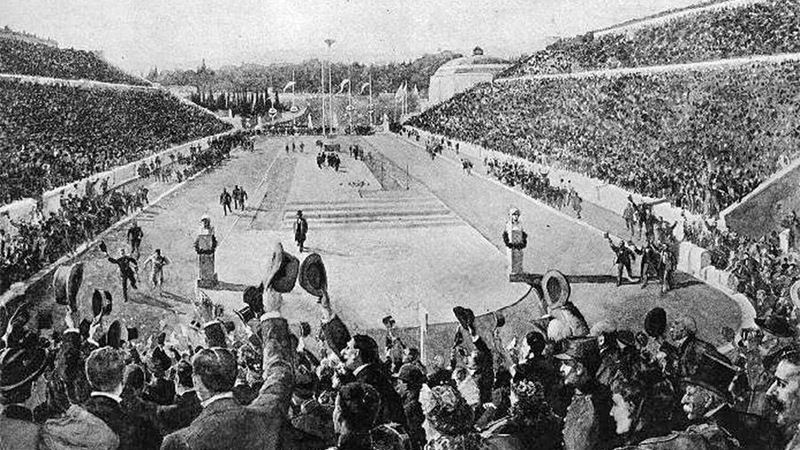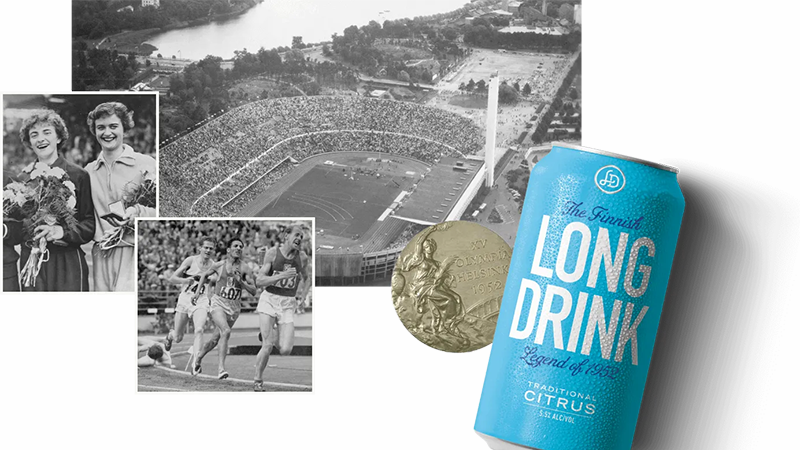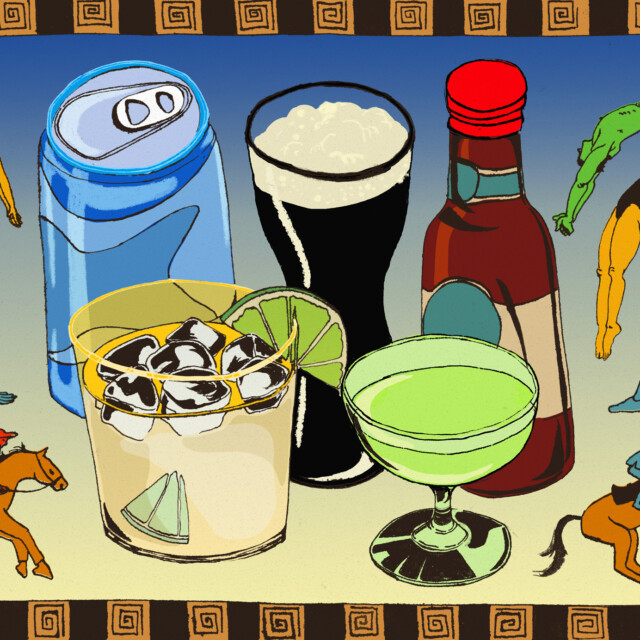In June 2023, it was announced that attendees of the 2024 Paris Olympics would be prohibited from drinking alcohol at events unless they were VIPs. Organizers justified the decision by citing a 1991 French mandate known as Evin’s Law, which bans alcohol from the general public in stadiums. They could have sought an exemption from the mandate, but they just chose to roll with it instead. Seven months after this bourgeois maneuver, the International Olympics Committee (IOC) announced AB InBev as its first-ever alcohol sponsor. While the financial details were undisclosed, similar sponsorship deals suggest the IOC made bank, and the partnership will extend through the 2028 games in Los Angeles.
For better or worse, booze and the Olympics have been inextricably linked since the modern games’ debut in 1896. Naturally, this pairing has produced shenanigans ranging from delightful to dangerous. After all, the Olympics represent the pinnacle of athletic glory, and alcohol consumption is practically its polar opposite. On a deeper level, they reveal historical subplots ranging from intriguing to embarrassing: the evolution of sports science; the overreach of good intentions; straight-up misogyny.
With the Paris games around the corner, it feels appropriate to take a look back at some of the ways that booze made its presence felt during the Olympics. Things are about to get weird.
Athens, 1896: A Mid-Race Cognac

It made perfect sense to hold the first modern Olympics in Athens, since the ancient Greek games inspired their traditions. Inventing a grueling long-distance race based on a legend where the main character dies made less sense, at least on paper — but that’s exactly how the marathon was created specifically for these first Olympic games.
Around the middle of the race, 23-year-old Greek shepherd and marathon participant Spyridon Louis allegedly stopped by a local inn and hung around long enough to drink a glass of Cognac. Some accounts swap the Cognac with wine. and some also say that he downed an egg. While what was in his glass is still up for debate, the fact that he drank some sort of alcohol mid-race is not. He wound up winning the race, much to the delight of the frenzied crowd.
St. Louis, 1904: A Poisonous Brandy Pick-Me-Up
The 1904 summer games were phenomenally messed up for many reasons: Take St. Louis’s brutal heat, its entanglement with the concurrent 1904 World’s Fair, and the racially charged influence of its chief organizer, white supremacist James E. Sullivan. Its marathon crystalized this chaos: Race-day temperatures rose above 90 degrees, cars carrying race officials along the route kicked up clouds of dust that choked the participants, and Sullivan only put one water station on the course because he wanted to track the effects of “purposeful dehydration.” A bunch of feral dogs chased one of the runners off course; the first person who crossed the finish line hitched a ride in a car for about 10 miles and was immediately disqualified. And then there was runner Thomas Hicks: About two-thirds into the race, an increasingly exhausted Hicks begged for water from his support staff, who was traveling behind him by car. They refused, choosing to sponge his mouth with warm water instead. Eventually, they provided Hicks with an elixir made of egg whites, brandy, and strychnine (a.k.a. rat poison) in the hopes that it would “revive” the beleaguered runner so he could finish the race. He began to hallucinate instead.
Despite these hallucinations and the loss of eight pounds during the contest, Hicks actually won. He was immediately stretchered off the course and treated by four doctors after crossing the finish line.
London, 1908: A Disastrous Booze Marathon
Another Olympiad, another example of booze and running being a horrible combination. Several marathon participants turned to the of-the-moment one-two punch of brandy and strychnine to get them through this race, undeterred by Hicks’ post-race condition four years earlier. The favorite to win, Canadian runner Tom Longboat, collapsed shortly after drinking Champagne in hopes of withstanding the scorching temperatures. South African marathoner Charles Hefferon had all but cemented his win when he accepted a glass of Champagne at around mile 24. He quickly suffered severe stomach pains and blew the lead. The runner who passed him, Italy’s Dorando Pietri, wasn’t in much better shape. He stumbled across the finish line with the help of a physician after collapsing several times — with a cork in his grasp.
This behavior wasn’t unheard of at the time. Back then, trainers theorized that Champagne and brandy were legal performance-enhancing substances because of their high sugar content, and they believed small doses of strychnine could boost muscle function. They’d eventually figure things out, but it would take some time — the marathon aid stations at the 1928 games in Paris were still offering white wine to competitors.
Helsinki, 1952: The Finnish Long Drink Is Born

In 1940, Helsinki was supposed to hold the summer games, but World War II kept that from happening for 12 more years. Finland’s capital was eager to show the world they were worth the wait, but they were also worried about having to serve the crush of visitors from around the globe efficiently. These concerns compelled Finland’s state-run alcohol control agency, Alko, to develop an easy-to-make alcoholic drink that could be served to attendees quickly. Alko solicited the aid of Finnish beverage company Hartwall to develop lonkero — a pre-mixed, carbonated, proto-RTD consisting of liquor and fruit — specifically for the games. It was such a smash among Olympic spectators that Hartwall expanded production after the games to sell lonkero commercially. Two versions hit the shelves later that year: the Brandy Long Drink made with red fruit, and the citrus-flavored Gin Long Drink.
Hartwall still produces the gin-based lonkero under the name Hartwall Original Long Drink. It’s now joined in the space by a few competitors, including the popular Finnish Long Drink.
Mexico City, 1968: Beer Gets an Athlete Banned
Rumors of Olympic athletes doping with substances like testosterone and amphetamines started spreading in the 1950s. By 1968, these rumblings were too loud for the IOC to ignore. It implemented in-competition drug testing for the Winter Olympics in Grenoble, France, and the summer games in Mexico City. The latter produced the first positive result when Swedish pentathlete Hans-Gunnar Liljenwall got busted for having an illicit substance in his urine. The substance? Beer.
Liljenwall had realized the Swedish team was in range for a potential medal, so he drank a couple of beers before the pistol-shooting round to calm his nerves. (Yes, there is pistol shooting involved in the pentathlon. It’s a weird event.) The team won the bronze medal but was disqualified and stripped of the prize once Liljenwall’s results came back beer-positive. Liljenwall never came as close to an Olympic medal ever again.
Vancouver, 2010: A Women’s Hockey Team Parties on the Ice
In 2010, the Canadian women’s hockey team captured its third consecutive gold medal by shutting out the U.S. 2-0. After receiving their medals, several players returned to the ice in full uniform, took a seat, and drank beer and Champagne while smoking cigars.
The IOC freaked out. It launched an investigation into the celebration and criticized the episode as something unbecoming of Olympians and against the Olympic spirit. The day after the game, IOC president Jacques Rogge threatened to remove women’s hockey from the games because the Canadians and the Americans were allegedly too good, and the team’s governing body, Hockey Canada, issued an apology. The stench of sexism and misogyny surrounding the IOC’s actions still lingers, as it’s nearly impossible to imagine the organization chastising the Canadian men’s hockey team for the same behavior.
